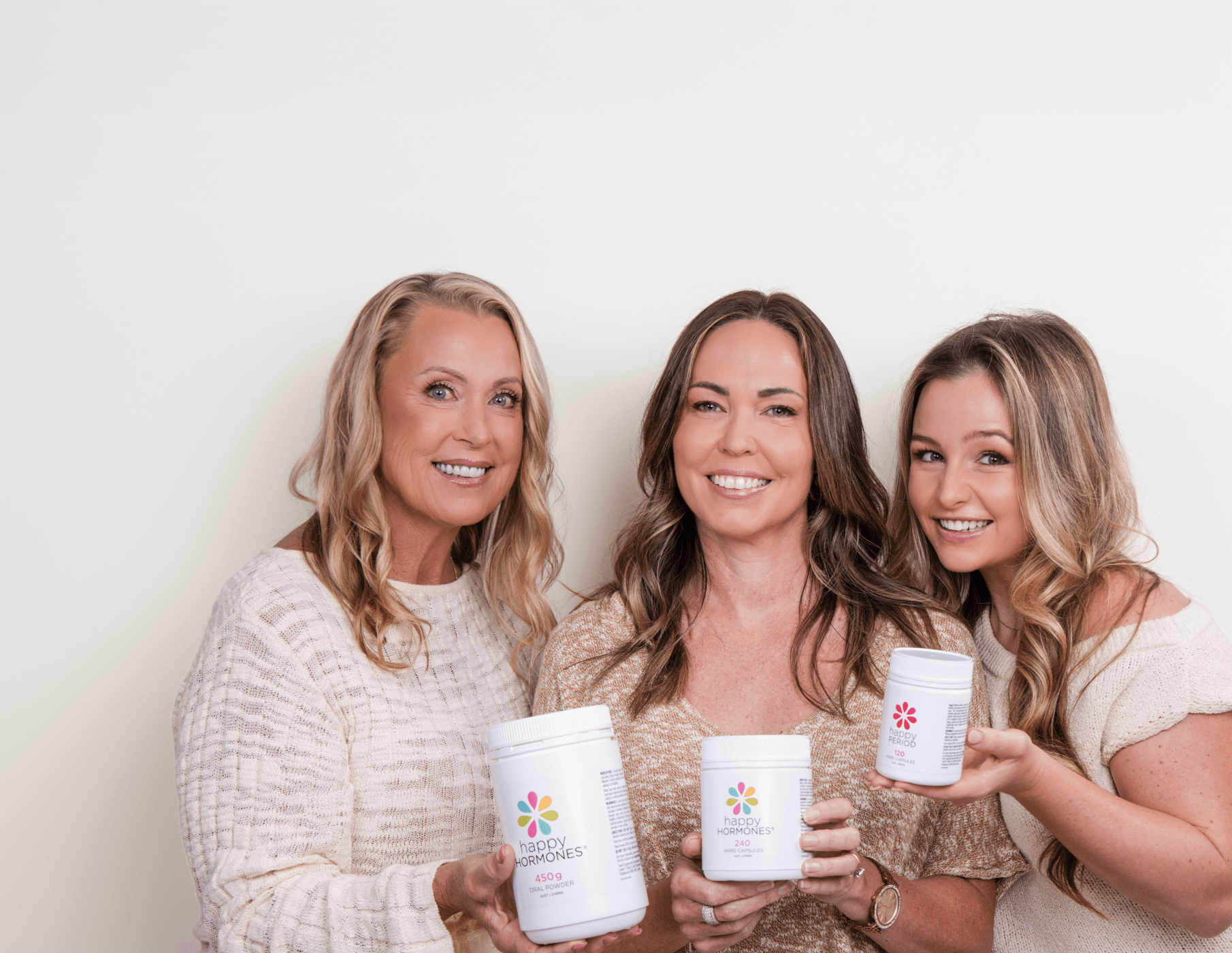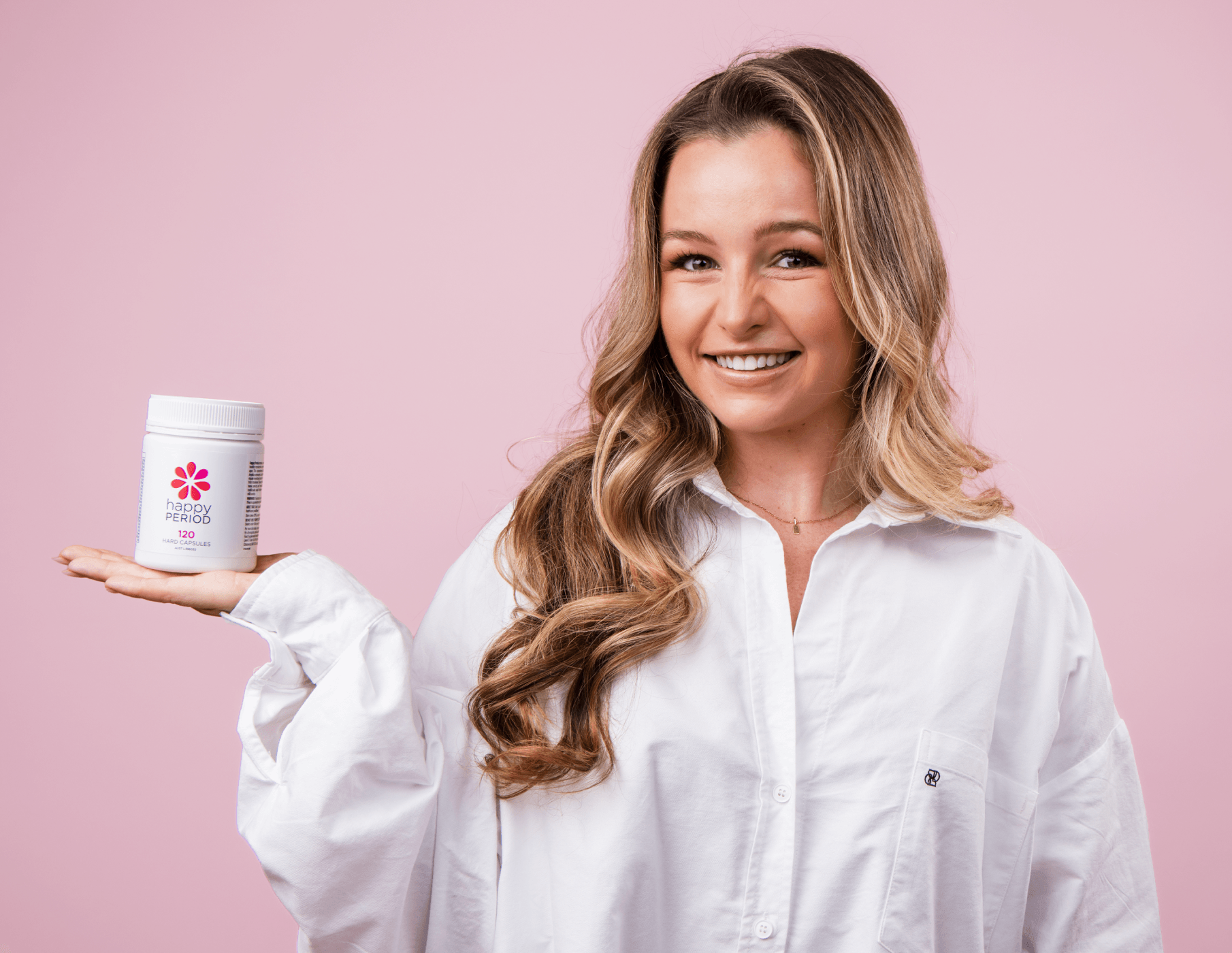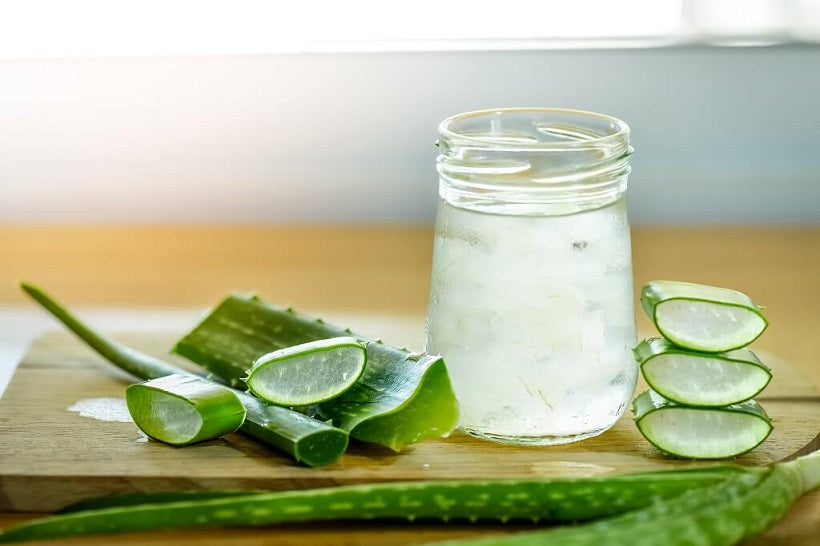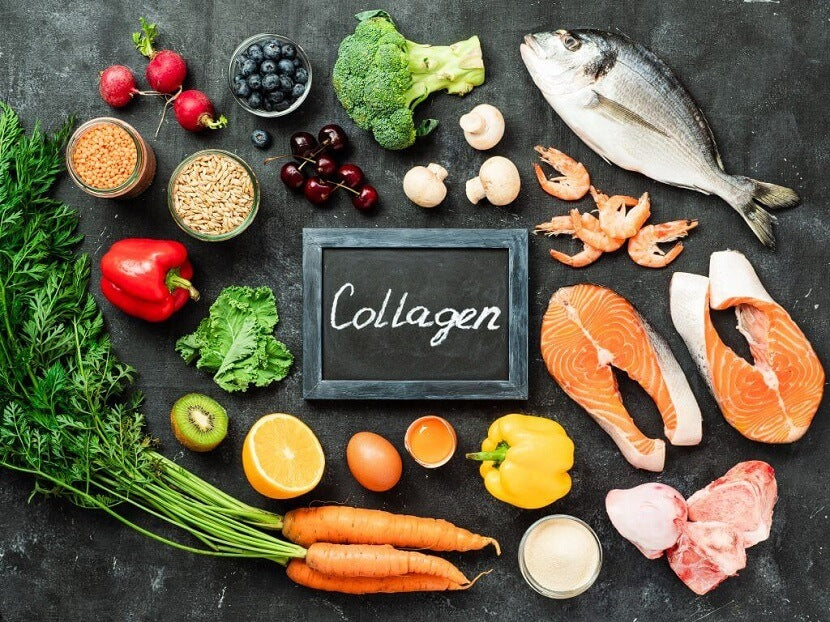10 Skin Nourishing Superfoods
By Renee Grandi

Want to nourish your skin from the inside? Here’s a list of our top 10 skin superfoods to add to your diet. You may also want to check out our Happy Skin Program if you’re looking for a comprehensive skin-nourishing nutritional program.
1: Celery & Cucumber Cold-Pressed Juice
Celery has an abundance of anti-inflammatory compounds ideal for nourishing the gastrointestinal tract and skin. Celery extracts nourish the liver, cardiovascular, lymphatic and connective tissues. It’s also anti-bacterial and anti-fungal against many pathological conditions, which makes it excellent for the microbiome, candida and skin microbiome.
Celery consists of skin-loving vitamins such as beta‐carotene, ascorbic acid, folic acid and minerals (sodium, potassium, calcium, and magnesium), silica, fibre, chlorophyll, and about 95% water, all of which are exceptionally nourishing to the skin matrix.
Cucumber is a skin-boosting superfood due to its abundance of B vitamins, silica, water, zeaxanthin, lutein, pantothenic acid, and vitamin C. We love cucumber for skin health as it naturally improves hyaluronic acid and elastin – vital for collagen and anti-wrinkle support.
Tip: Start your morning on an empty stomach with celery, cucumber, ginger, turmeric, Happy Greens and parsley green juice - you’ll thank me later!
2: Berries (especially acerola cherries)

Organic berries are known to be a skin and vitality superfood due to their high antioxidant, vitamin-C and carotenoid content. Acerola fruit contains an exorbitant amount of ascorbic acid in the range of 1500–4500 mg/100 g, which is around 50–100 times more than an orange or lemon. Just 3 acerola cherries per day would be sufficient for the adult dietary intake of Vitamin-C.
These delicious fruits are abundant in skin-loving nutrients such as Vitamin A, iron, calcium and B-vitamins. Studies have also shown promising health benefits of berries for the cardiovascular system, liver, and blood sugar regulation.
Berries are a supreme food source for skin healing and rejuvenation - plus they taste amazing!
Food sources: acerola cherries, gooseberries, blackberries, mulberries, cherries, strawberries, blueberries, raspberries, blackcurrants, cranberries, lingonberries, boysenberries, acai berries, goji berries, cape gooseberries
*Berries are best fresh, not dried unless in an unsweetened powder form to avoid excessive sugar intake.
3: Well-sourced Algae (Spirulina, Chlorella, Bluegreen)
Algae contain collagen-building amino acids and alkalising, nutrient-dense and blood-cleansing phytonutrients.
Spirulina, chlorella and bluegreen are skin superfoods. These green superfoods deeply cleanse the blood, balance hormones, improve skin tissue and so much more (we seriously love them for detoxing the skin). Spirulina contains omega-3 essential fatty acids that support the skin barrier. Plus – you get to make everything a whimsical green colour – hello unicorn smoothie bowls!
Well-sourced algae are also renowned for:
- Reducing inflammation
- Systemic detoxification
- Protecting against UV radiation
- Increasing collagen I formation
- Improving DNA sequencing
- Skin hydration, skin firming and preventing wrinkle formation
We love beautiful algae so much and could go on about it forever. Every skin type can benefit from a dose of high-quality algae each day.
4: Nuts & Seeds
Nuts and seeds are enriched with alpha-linolenic acid, an omega-3 essential fatty acid that decreases skin reactivity and mediates immune-related inflammation. They improve blood sugars, cognition, hormonal and skin health. Sensitive, inflamed, rough, dry skin can benefit from increasing nuts, seeds and organic cold-pressed plant-based oils into the daily routine.

Research also suggests that the nutrients from nuts and seeds balance inflammation and support skin membranes for healthy aging. Increased intakes of nuts and seeds are positively and linearly associated with improved DNA/RNA telomere length, aiding in meaningful decreases in biologic aging and cell senescence.
We especially love well-sourced flax and hemp oils for skin nourishment.
Seeds:
- Sesame
- Flax
- Hemp
- Pumpkin
- Sunflower
- Chia
Nuts:
- Brazil
- Walnuts
- Almonds
- Macadamia
- Cashews
- Pecan
- Hazelnut
- Pine
- Pistachio
We’ve formulated the Happy 5 Mix
This Mix includes sesame seeds, flax seeds, hemp seeds, Brazil nuts and pepitas. Check out the recipe here to add to your daily skincare cosmeceutical routine.
5: Kefir Water or Coconut Kefir Water
Kefir contains an abundance of probiotics and antimicrobial substances for skin health including:
- Bacteriocins
- Lactic acid
- Acetic acid
- Hydrogen peroxide
It’s also shown to inhibit inflammatory bacteria:
- A. Aureus
- S. salivarius
- S. pyogenes
- P. aeruginosa
- C. albicans
- S. tympimurium
- L. monocytogenes
- E. coli growth
Kefir is the perfect way to get creative with your daily dose of probiotics. You can make herbal teas and ferment them for that extra glow!

Add your kefir water to smoothies, juices, or healthy indulgent mocktails!
Tip: We love rosehip, butterfly pea, turmeric, ginger and even a nice fresh cinnamon stick.
Fermented tea in 5 easy steps:
Step 1: Bring a 2-3L pot of water to boil and add a big handful of fresh herbs.
Step 2: Let boil for 15 minutes, then simmer on low for 2 – 3 hours.
Step 3: Let the enriched tea cool then pour into a large glass jar.
Step 4: Add in a teaspoon of coconut sugar + your kefir grains and ferment overnight (cover the top with a muslin cloth).
Step 5: You know it’s ready to drink when there’s some carbonation in the tea.
You can drink 1 – 2 cups of this per day. This can be refrigerated for up to 3 days.
Bonus tip: Blend some ice, add fresh mint and blueberries to have the ultimate healthy mocktail.
6: Raw Cacao
Cacao flavanols have shown the following benefits:
Promotes prebiotic activity in the gut microbiome
- Improves liver detoxification of accumulated fats
- Delivers excellent anti-inflammatory properties
- Exhibits favourable attributes to reverse skin aging
- Reduces excessive sebum production
- Balances the skin microbiome
- Protects the skins dermal structures
- Improves skin elasticity integrity and reduces skin matrix deterioration
Cacao is an excellent antioxidant for skin-related issues and is rich in essential fatty acids, antioxidants, magnesium, iron, and polyphenols.
Increasing the combination of raw cacao and lycopene together over 4 weeks shows promising results for enhanced liver metabolism, particularly in regards to skin detoxification.
Plus it makes everything taste super delish! Add it to smoothies, energy balls, porridge, chia seed puddings or melt with some coconut oil and drizzle on berries – yummo!
7: Turmeric
Turmeric contains a compound called curcumin – we love curcumin for skin health because it is the queen of reducing inflammation. This golden super-herb is therapeutically proven to improve:
- Acne
- Alopecia
- Atopic dermatitis, psoriasis and pruritus
- Facial aging
- Vitiligo and melasma
In combination with black pepper, turmeric's bioavailability increases by 2000% (which is why we formulated Happy Turmeric for top-quality absorption and utilisation).
This herb is a skin and hair powerhouse – reducing inflammation, balancing immune stressors, and improving digestion. This herbal synergy is a must-have when it comes to skin healing and protection. Turmeric is an herb for vitality and works on so many different levels – any inflamed skin condition, allergies, or wrinkle prevention could benefit from a little curcumin. Read Turmeric for Skin Health to learn more.
8: Wild-caught, Sustainable Fatty Fish
Fish is rich in macronutrients: proteins, lipids, vitamins and minerals. Fish lipids are highly bioavailable due to their n-3 poly-unsaturated fatty acids (PUFAs) EPA and DHA. Linoleic acid (LA) is a dominant omega-6 PUFA in fish oil and is essential for healthy reproductive and skin function. LA is the most abundant fatty acid in the skin's epidermal layer. LA can be metabolized to skin-loving acids such as γ-linolenic acid (GLA), prostaglandin (PG)E1, and arachidonic acid (AA).
These eicosanoids are excellent in mediating inflammatory and allergic skin responses. Fish contains selenium and iodine important for thyroid functionality as well as iron to synthesize hemoglobin and prevent anemia. Calcium, vitamins A, D and Bs are naturally present in fish, making fish sources a skin-nourishing superfood. The oils in fish have been shown to improve skin protective barriers, dermal matrix layers, inflammatory markers and oxidative stress responses.
Sources: Salmon, sardines, rainbow trout, mackerel, herring and fish oil.
9: Organic Chicken Bone Broth
Bone broth is one of the rare foods that beholds bioavailable high concentrations of collagen, minerals and collagen-building amino acids. This nourishing food is composed of:
- Skin matrix essential glycosaminoglycans (GAGs)
- Chondroitin sulfate
- Keratin sulfate
- Hyaluronic acid
Amino acids:
- Glutamine: Enhances cell regeneration, glutathione production, and gut health
- Hydroxyproline: Beneficial for skin health by increasing collagen production and crucial for wound healing
- Hydroxylysine: Interacts with other collagen amino acids to form the collagen tripeptide molecule and great for immunity
Collagen is the most abundant protein present in all human tissues, with type I and III comprising 90% of the skin's dermal layers. These forms of collagen are excellent for reducing inflammation and skin matrix deterioration, and is a major component of the skin extracellular matrix.
Bone broth directly nourishes the gastrointestinal lining, connective tissue, immune system, joints, skin, lungs, muscles and blood. It’s the perfect base to many recipes such as soups, sauces, gravy, or simply add a handful of fresh greens as a hearty cuppa soup snack.
10: Avocado

Where to start with the health benefits of this nutrient-dense fruit? Well, let's list them, shall we? Avocados contain unique bioactive constituents such as phytochemicals, phytosterol, vitamins, minerals, and fibre:
- β- sitosterol: helps to reduce impulsive eating, improve immune responses & inactivates invading pathogens
- Phytosterol: Improves cholesterol and fatty liver by replacing saturated fats with unsaturated fats
- Valuable amounts of PUFAs
- Abundant in bioactive components; carotenoids (zeaxanthin, lutein, beta-carotene), phenolic compounds, magnesium, B-complex vitamins + E and C
- Rich source of both soluble and insoluble fibre
- Contains a considerable amount of pigments, phytoestrogens, polyphenols, and tannins
- High in glutathione, which is considered a strong antioxidant
We definitely recommend adding organic, cold-pressed avocado oil to your salads, vegetables and dressings.
Note: Do not heat avocado oil.
Key Takeaway
Now you know why we love these superfoods and why it’s important to add them into your diet for optimal skin results. Check out our Happy Skin by Lisa Curry™ Optimal Skin Guide for nutritionist-approved skin-nourishing recipes.

REFERENCES
Sowbhagya HB. (2013). Chemistry, Technology, and Nutraceutical Functions of Celery (Apium graveolensL.): An Overview. Critical Reviews in Food Science and Nutrition, 54(3):389-98.
Hedayati N, Naeini MB, Mohammadinejad A, Mohajeri SA. (2019). Beneficial effects of celery ( Apium graveolens ) on metabolic syndrome: A review of the existing evidences. Phytotherapy Research. Dec;33(12):3040-3053.
Uthpala TGG, Marapana RAUJ, Lakmini KPC, Wettimuny KC. (2020). Nutritional Bioactive Compounds and Health Benefits of Fresh and Processed Cucumber (Cucumis Sativus L.). Sumerianz Journal of Biotechnology, Vol. 3, No. 9, pp. 75-82.
Mukherjee PK, Nema NK, Maity N, Sarkar BK. (2013). Phytochemical and therapeutic potential of cucumber. Fitoterapia, Jan;84:227-36.
Nema NK, Maity N, Sarkar B, Mukherjee PK. (2010). Cucumis sativus fruit-potential antioxidant, anti-hyaluronidase, and anti-elastase agent. Archives of Dermatological Research, May;303(4):247-52.
Prakash A & Baskaran R. (2018). Acerola, an untapped functional superfruit: a review on latest frontiers. Journal of Food Science and Technology, Sep;55(9):3373-3384.
Wells et al. (2016). Algae as nutritional and functional food sources: revisiting our understanding. Journal of Applied Phycology, 29(2):949-982.
Wu et al. (2016). The antioxidant, immunomodulatory, and anti-inflammatory activities of Spirulina: an overview. Archives of Toxicology, Aug;90(8):1817-40.
Lolou V & Panagiotidis MI. (2019). Functional Role of Probiotics and Prebiotics on Skin Health and Disease. Fermentation, 5(2):41.
Faria-Silva et al. (2020). Feeding the skin: A new trend in food and cosmetics convergence. Trends in Food Science & Technology, v.95 pp. 21-32.
Siebecker A. (2005). Traditional bone broth in modern health and disease. Townsend Letter for Doctors and Patients, no. 259-260, p. 74+. Gale Academic OneFile . Accessed 20 May 2021.
Cardoso BR, Silva Duarte GB, Reis BZ, Cozzolino SMF. (2017). Brazil nuts: Nutritional composition, health benefits and safety aspects. Food Research International, Oct;100(Pt 2):9-18.
Huang TH, Wang PW, Yang SC, Chou WL, Fang JY. (2018). Cosmetic and Therapeutic Applications of Fish Oil’s Fatty Acids on the Skin. Marine Drugs, Aug; 16(8): 256.
Lin et al. (2020). Protective effects of dietary fish‐oil supplementation on skin inflammatory and oxidative stress biomarkers induced by fine particulate air pollution: A pilot randomised, double‐blind, placebo‐controlled trial. British Journal of Dermatology, Feb;184(2):261-269.
Majid D et al. (2020) Avocado. In: Nayik GA, Gull A. (eds) Antioxidants in Fruits: Properties and Health Benefits. Springer, Singapore.
Tucker LA. (2017). Consumption of nuts and seeds and telomere length in 5,582 men and women of the National Health and Nutrition Examination Survey (NHANES). The Journal of Nutrition, Health & Aging, 21(3):233-240.
Singh M, Agarwal S, Agarwal M, Rachana R. (2020). Benefits of Theobroma cacao and Its Phytocompounds as Cosmeceuticals. In Swamy MK (ed.). Plant-derived Bioactives, pp. 509 - 521. Springer.
da Mata et al. (2020). Benefits of turmeric supplementation for skin health in chronic diseases: a systematic review. Critical Reviews in Food Science and Nutrition, Jul 27;1-15.
Vaughn AR, Branum A, Sivamani RK. (2016). Effects of Turmeric (Curcuma longa) on Skin Health: A Systematic Review of the Clinical Evidence. Phytotherapy Research, Aug;30(8):1243-64.
Labban L. (2014). Medicinal and pharmacological properties of Turmeric (Curcuma longa): A review. International Journal of Pharmaceutical and Biomedical Sciences, 5(1):17-23.
Wiese et al. (2019). Prebiotic Effect of Lycopene and Dark Chocolate on Gut Microbiome with Systemic Changes in Liver Metabolism, Skeletal Muscles and Skin in Moderately Obese Persons. BioMed Research International, Jun 2;2019:4625279.
Shaw MH & Flynn NE. (2019). AMINO ACID CONTENT OF BEEF, CHICKEN AND TURKEY BONE BROTH. Journal of Undergraduate Chemistry Research, 18(4), 15.








Leave a comment
This site is protected by hCaptcha and the hCaptcha Privacy Policy and Terms of Service apply.